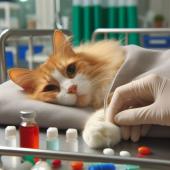Antibiotic treatment in cats

Antibiotic treatment
Since the discovery of penicillin by Alexander Flemming in 1928, antibiotics have saved millions of lives, in both human and veterinary medicine. They are an invaluable tool used against many diseases and are incredibly useful in veterinary as well as human medicine.

What are antibiotics?
Antibiotics are essential medications that cure bacterial illnesses; they either eradicate or inhibit the growth of pathogenic germs. Antibiotics come in a variety of varieties. It's crucial to keep in mind that antibiotics are primarily effective against bacteria; they cannot treat many other illnesses, including viral and fungal infections. Some of the more common antibiotics include:
- Penicillins, eg penicillin G and amoxicillin.
- Cephalosporins, eg cefaclor, cefadroxil, cefalexin, cefovecin, and ceftiofur.
- Tetracyclines, eg tetracycline, minocycline, and doxycycline.
- Aminoglycosides, eg gentamicin and amikacin.
- Lincosamides, eg clindamycin, lincomycin, and pirlimycin.
- Suphonamides and trimethoprim, eg co-trimoxazole.
- Nitroimidazoles, eg metronidazole, ronidazole, and tinidazole.
- Quinolones, eg ciprofloxacin, enrofloxacin, levofloxacin and norfloxacin.
- Macrolides, eg erythromycin, azithromycin, clarithromycin, and tylosin.
What are the potential dangers of using antibiotics?
The goal of antibiotics is to "kill" bacteria, either directly or by halting their growth until they become extinct. Certain antibiotic classes are not selective in the bacteria they destroy. This implies that many antibiotics have the potential to eradicate both beneficial and dangerous bacteria from the digestive system, which can have serious adverse effects. gastrointestinal symptoms, such as nausea, vomiting, and diarrhea, are frequently experienced and may be caused by the death of both beneficial and harmful bacteria in the gut, which damages the gut's biome.
Antibiotics can become ineffective in treating the intended infection if they are used erratically or at doses too low to be useful because bacteria can develop resistance to them. Antibiotics must thus be administered precisely as prescribed by the veterinarian, for the prescribed amount of time each day and for the prescribed length of therapy.
Any drug can have adverse responses, and any animal can experience them. Any medicine has potential hazards, and no drug is ever completely safe in every circumstance. Although adverse responses are possible, the risks can be reduced by using the right antibiotics at the right dosage for the right length of time.
Antibiotic side effects can come in many different forms, but serious reactions are uncommon, and if medications are taken exactly as directed by the veterinarian, the risks of not treating an illness exceed any possible risk of receiving antibiotic treatment. Antibiotic-related allergies in cats can manifest as rashes, itchy skin, hives, and occasionally swelling lips or cheeks. Rarely, certain antibiotics can set off an auto immune reaction that results in lameness, edema, and joint pain.
Antibiotics can affect the synthesis of blood cells; symptoms include appetite loss, sadness, and reluctance to exercise or jump. In rare instances, certain antibiotic kinds might cause neurological symptoms like seizures, stumbling, and head tilt. Certain medications can harm developing kittens by impairing bone formation, which is why they should not be given to young animals or pregnant queens. There has been evidence linking some fluoroquinolone drugs, such as enrofloxacin, to blindness in cats. Care must be taken with any animal whose liver or kidneys are known to be problematic because other antibiotics may exacerbate these conditions.
When your pet is prescribed medication, make sure you read the accompanying information leaflet and ask your veterinarian if there are any warning indications in particular that you should be aware of. When giving your pet medication, always keep a watchful eye out for any adverse effects, and contact your veterinarian right away if you have any concerns. Also, keep in mind how crucial it is to provide the medicines precisely as directed by the veterinarian.
When are antibiotics useful?
In veterinary medicine, antibiotics play a critical function; without them, we would be significantly less effective in treating a wide range of ailments.
When it comes to fungal or viral infections, antibiotics are ineffective. However, damage from fungal and viral infections can lead to secondary bacterial infections in cats. In this case, your veterinarian might recommend antibiotics.
Antibiotics are helpful in treating bacterial infections (such as abscesses, respiratory, urinary, skin, and eye infections) as well as in preventing wound infections (such as those caused by trauma or after surgery). In certain cases, your veterinarian may give your pet antibiotics right before surgery in order to stop bacterial infections in the incision.
When Are Antibiotics Prescribed for Cats?
Veterinarians may prescribe antibiotics for cats in the following situations:
-
Bacterial Infections: Antibiotics are used to treat various bacterial infections, such as respiratory infections, urinary tract infections, and skin infections.
-
Post-Surgical Care: After surgeries, especially those involving internal organs, antibiotics may be prescribed to prevent infections.
-
Dental Procedures: Cats undergoing dental cleanings or extractions might receive antibiotics to prevent oral infections.
-
Wounds and Injuries: Antibiotics can help prevent infections in wounds, bites, or injuries that break the skin.
How does my vet know which antibiotic to use?
Antibiotics differ in their effectiveness against different kinds of bacteria; some are broad spectrum antibiotics, which are effective against a wide range of bacteria, while others may only be effective against one or two species of bacteria (narrow spectrum antibiotics).
Ideally, before beginning any antibiotic treatment, a culture and sensitivity test should be performed. To do this, a sample of any discharge from the afflicted area—such as a wound, body fluid, or orifice—must be taken. After that, the sample is submitted to a lab where the bacteria are cultured and tested against a range of antibiotics to determine which one kills the bugs the best.
While awaiting the results of the culture and sensitivity tests, your veterinarian might begin treating your pet with a broad range antibiotic because identifying the specific bacteria causing the issue could take several days. To decide a broad spectrum antibiotic to start with, some veterinarians may perform an in-office test called a gram stain or they may rely on their professional experience treating infections. Given the difficulties veterinarians encounter in treating patients with antibiotic resistance, culture and sensitivity testing is becoming more and more crucial. Making sure the antibiotic being used is effective is crucial since your cat has the best chance of recovering if the illness is treated as soon as possible.
How are antibiotics administered?
Antibiotics can be administered orally as pills, capsules, or liquid; alternatively, your veterinarian may inject the medication intravenously, subcutaneously, or into a muscle. Rarely, your veterinarian may instruct you on how to administer shots to your pet at home. If your pet gets a skin illness, you can be prescribed an antibiotic shampoo to wash the affected area or an antibiotic cream to apply directly onto the lesion. If you are the one administering antibiotics to your cat, you need to make sure you follow the prescription exactly, which includes delivering the proper dosage at the right time and seeing through the entire course of treatment—even if your cat seems to be getting better after just a few days.
If you forget to take an antibiotic dose, consult the information sheet that came with the prescription. If you don't have access to this sheet, ask your veterinarian for guidance. Antibiotic drug information sheets intended for human use should be avoided as they usually exclude crucial details regarding the usage of the antibiotic in animals. Since most antibiotics have a broad safe margin, delivering the dose as soon as you recall and the next dose at the scheduled time will usually suffice. However, unless your veterinarian specifically instructs you to do so, avoid doubling up on dosages as this may result in additional negative effects.
Administering Antibiotics to Cats: Best Practices
-
Follow Veterinary Advice: Always follow the veterinarian's instructions regarding the type of antibiotic, dosage, and duration of treatment. Do not adjust the dosage or stop the medication without consulting the vet.
-
Oral Medication: Most antibiotics for cats come in the form of pills or liquid. Use pill pockets or mix the liquid medication with a small amount of cat food to make it easier for your cat to consume. Ensure your cat swallows the entire dose.
-
Syringe Feeding: If your cat refuses to take oral medication, use a syringe to gently administer the liquid antibiotic into the back of the cat's mouth. Be careful not to choke the cat.
-
Consistency: Administer antibiotics at the same time every day to maintain consistent levels of the medication in the cat's system.
-
Complete the Course: It's crucial to complete the entire prescribed course, even if your cat appears to have recovered. Stopping the medication prematurely can lead to antibiotic resistance.
-
Watch for Side Effects: Keep an eye out for any adverse reactions such as vomiting, diarrhea, or allergic reactions. If you notice any unusual symptoms, contact your veterinarian immediately.
What about antibiotic resistance?
In human medicine, antibiotic resistance is quickly becoming into a significant issue, and in many veterinary circumstances, it is taking a similar turn. Animals are treated with many of the same antibiotics that are used in human therapy.
Since bacteria are living things, they have the ability to adapt and withstand the effects of antibiotics. This is particularly true if the antibiotics are administered sporadically or at dosages that are ineffective. These bacteria may eventually develop "antibiotic resistance," which means the antibiotic is no longer effective against that particular strain of bacteria. It is crucial to only use antibiotics when they are really essential since every time we use an antibiotic, we run the danger of developing resistant germs.
The primary cause of antibiotic resistance is not finishing the entire specified course of therapy or skipping too many pills. The sensitivity of bacteria to antibiotics varies. In an infected tissue, the more susceptible bacteria are typically destroyed first, necessitating additional antibiotic dosages to kill the more resistant germs. The more resilient bacteria survive if antibiotics are stopped too soon; they "remember" that the antibiotic did not kill them, modify their body defenses, and procreate to form a new colony that is less likely to be destroyed by that antibiotic. Once additional bacteria learn about it, resistance begins to spread throughout the entire population of bacteria. It is possible for a bacterium to develop resistance to every antibiotic now in use.
Antibiotics should never be used needlessly, but we can slow down the emergence of resistance by using them less frequently. Always take antibiotics as directed by a doctor, giving them the right dosage and duration of time.
Cats that are battling illness benefit greatly from the use of antibiotics. To preserve the advantages they provide to veterinary and human care, it is crucial that they be handled with respect. If your veterinarian prescribes antibiotics for your pet, always make sure to follow their directions.
Preventing Antibiotic Resistance
-
Proper Diagnosis: Ensure that the condition is correctly diagnosed before requesting antibiotics. Unnecessary use can contribute to antibiotic resistance.
-
Probiotics: Discuss the use of probiotics with your veterinarian. Probiotics can help maintain a healthy balance of gut bacteria during and after antibiotic treatment.
-
Avoid Sharing Medication: Never share antibiotics prescribed for one pet with another, as the medication might not be suitable for different conditions.
-
Regular Veterinary Check-ups: Schedule regular check-ups to monitor your cat's health. Veterinarians can assess if antibiotics are necessary and prescribe them when appropriate.
Conclusion
Antibiotics are powerful tools in veterinary medicine, helping cats recover from bacterial infections. Responsible antibiotic use, under the guidance of a veterinarian, is essential to ensure the health and well-being of your feline companion. By following veterinary advice, administering medications as directed, and being aware of the importance of completing the prescribed course, cat owners play a crucial role in maintaining the effectiveness of antibiotics and safeguarding their pets' health.






